April/May 2011
Ali Baba et la Gazelle Jolie
Exploring more of Morocco’s Charms
Maunday, Tuesday, Thursday, Wednesday…
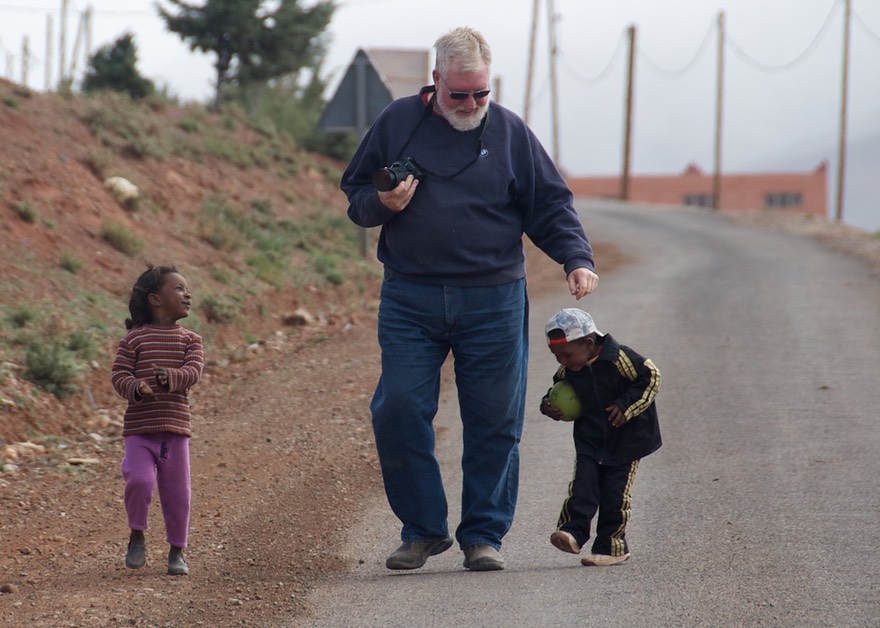
www.Moroccoweather.com gets easily confused; either that or they are terrific fans of “The Godfather.” And to top it off, sometimes, but only sometimes, they screw up and say “Lundi” (which is Monday in French). Do they really mean that the weather that comes on the day after Tuesday (on their chart) is for Thursday, or for the day after Tuesday???. Makes it hard to plan ahead, but who cares. Whimsical, to the very end and, honestly, we’re not making this up; check for yourself, we’ve posted a picture on the photo page for this message.
Well, we left you in Tafraoute. Have you been having fun there? Did you enjoy all the goats passing back and forth in front of your campsite? Aren’t they a kick, trying to eat the tops of the bushes? We wondered if these were the same goats as those famous ones who are so important in producing argan oil? It seems they climb into the argan trees (a variety of oak) and eat the outer part of the fruit, ingesting and then eliminating the nuts, which are used to produce the oil. Big business hereabouts. These guys were fakes; we finally saw some of the real ones in the trees, in another part of Morocco.
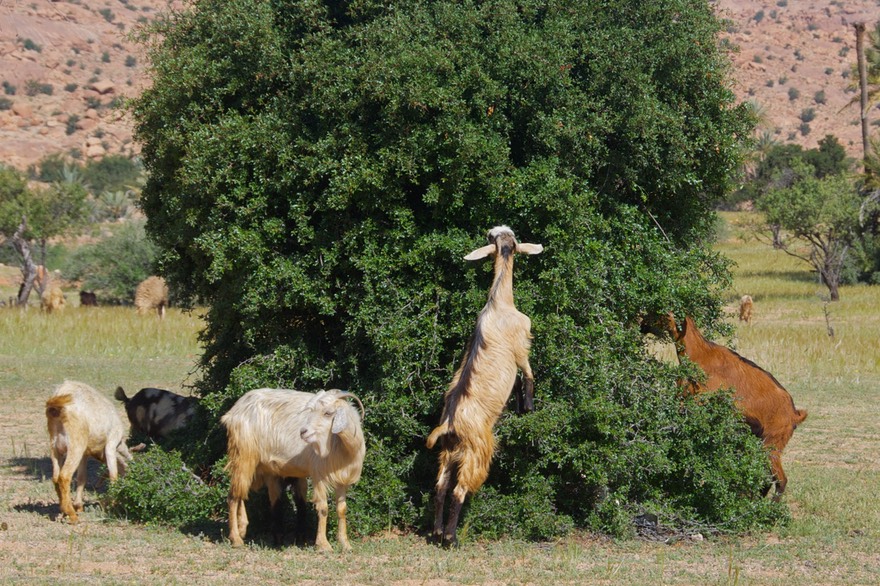
We spent a couple of very nice days in Tafroute, and then wandered the region. It’s lovely, with interesting terrain, including some enormous rocks that have been painted various garish colors. Quite ridiculous, but we had a delightful, quiet night parked among them on a bluff with great views. We had started out on a long loop that would take us down into a gorge on decent road, and then a long ways around on a less-than-decent road but through fabulous countryside. At the bottom of the canyon, at Aït Mansour, we ran into a very interesting couple from Luxembourg and spent some time chatting with them. Neat folks. They told us they had come down “the other way” and that we shouldn’t attempt it, due to extremely low overhanging trees; rats, but we always take serious advice seriously. So we ended up turning around and retracing our steps, enjoying the views just as much going in the other direction, and then spending the night among the painted rocks.
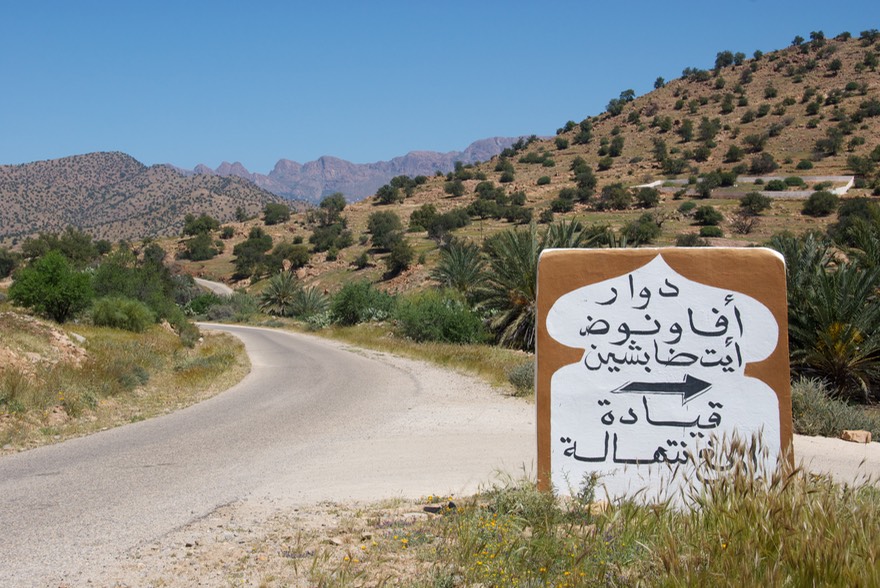
Tafraoute was a great spot (in fact, one of our Morocco favorites), but we finally tore ourselves away. We began heading for Marrakesh, following a dry oud (wash) up a valley filled with wildflowers. We wandered through Igherm, past the Anamer agidir, and on to Taliouine. (Aren’t these words wonderful?) This was all on decent secondary road, through rugged, isolated, dry mountains; then at some point we crossed into a different valley and suddenly we began seeing green again. This wash was dry now, but the river that inhabited it had caused tremendous damage during the snowmelt. The road was a mess in places, and only some of the repairs had been completed.
At some point we stopped in a small town while Rick went to find an ATM. The truck was parked next to a tailor sitting outside his shop mending a garment. Next door was a spice market. I’ll never forget the sights and smells of that moment.
But Marrakesh was beckoning, with a sly gleam. We had decided we’d never be able to look our friends in the face if we didn’t go there, but neither of us (1) likes cities, or (2) thinks this will be one we will enjoy. In the end I wanted to see the snake charmers. So off we went. We climbed up a narrow road built by the French in the 20s toward the Tizi n’Test pass, a biggie, stopping late in the afternoon in Tin Mal to see the ancient mosque there. What a great spot! It was built about 1150, is partially restored and is, except on Fridays, open to non-Muslim visitors (unlike virtually all mosques). For a small fee we had a personal tour and then were left to wander at will. The mosque is mostly open to the sky, and is a very nice blending of old and new. We really enjoyed the experience.
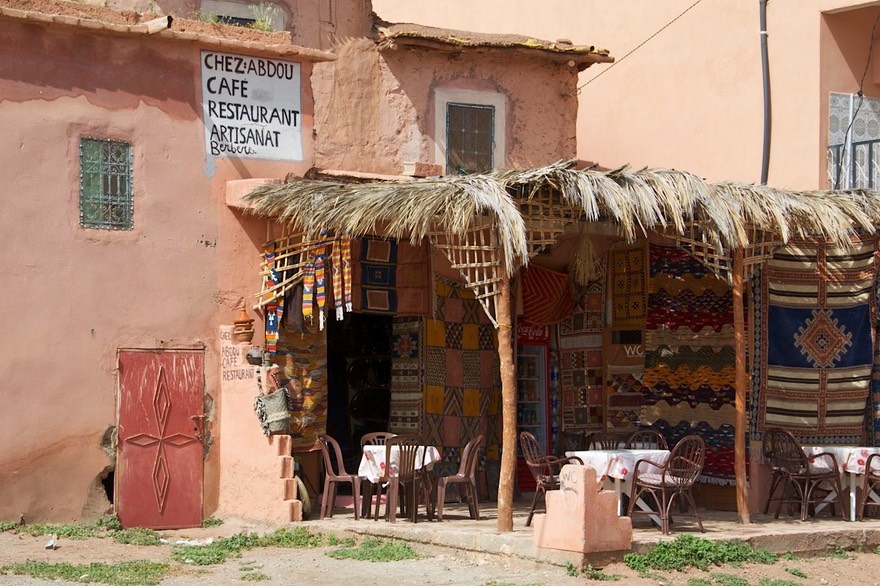
Afterwards, we stepped across the way to Café Abdou for tea and a chat. Abdou was the height of charm, serving us graciously, conning us out of a bottle of wine in exchange for the tea, and being happy to give us permission to park up for the night in the mosque’s parking lot. Declaring us lovely people, he gave us new names and a wonderful title for this message: Ali Baba et la Gazelle Jolie; we’ll leave it to your imagination to choose who is who. The guardian at the mosque had convinced me to donate some clothing “for the children.” These folks are marvelous at the soft sell approach! We fell asleep with a soccer match (in the dark) still going on down the hill. The next morning we were entertained by the village goats wandering through, several groups of folks going about their business, and a patch of stunningly beautiful cactus in full bloom. What a great spot!
Wending our way on up the pass, we tacked repeatedly back and forth on a very squiggly road, finally reaching the top at 6900 feet before beginning the drop (equally squiggly) down towards the plains surrounding Marrakesh.
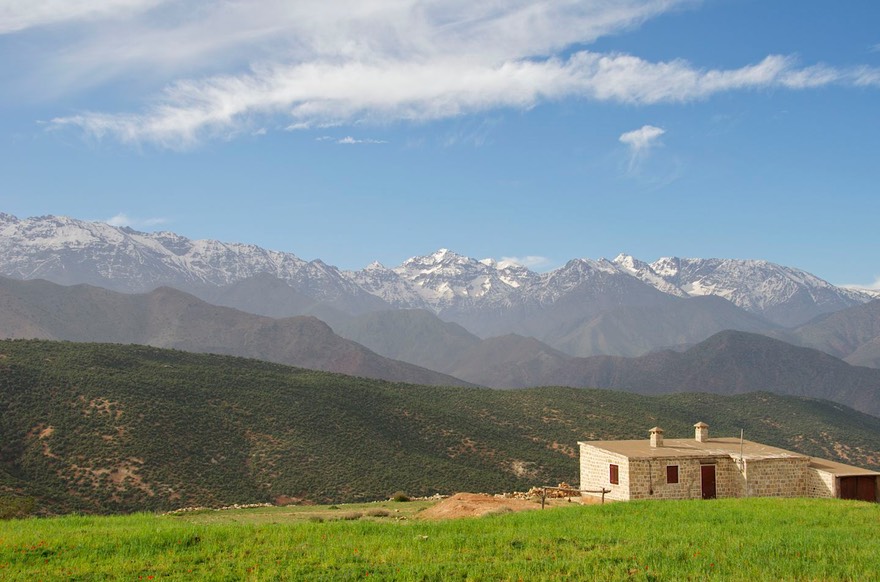
We did make one detour along the way, crossing over the mountains on a tiny, back road that was lovely; it was quite doable although it suffered from several nasty washouts; we then dropped down through Imlil and then into the Ourika Valley, playgrounds for Marrakesh on holiday. They were pretty, but also pretty touristy, complete with camels to sit on, vendors galore, and tajine pots/rugs/trinkets on offer. We kept going, on into the city.
Ah, Marrakesh. What to say. By now you know we managed to come and go before the bombing, and our hearts go out to the families of those who were hurt or killed on that awful day.
Marrakesh is a huge tourist destination, and with good reason. It is exotic and full of interesting things to see. Having visited Fez, we felt the medina was rather second-rate; also, it was jammed with scooters and motorbikes, being used for deliveries as well as just plain old transportation. Dodging motorbikes and smelling their fumes adds nothing to the charm of any city. Fez, with its burros and handcarts, just went up a thousand-fold in our estimation.
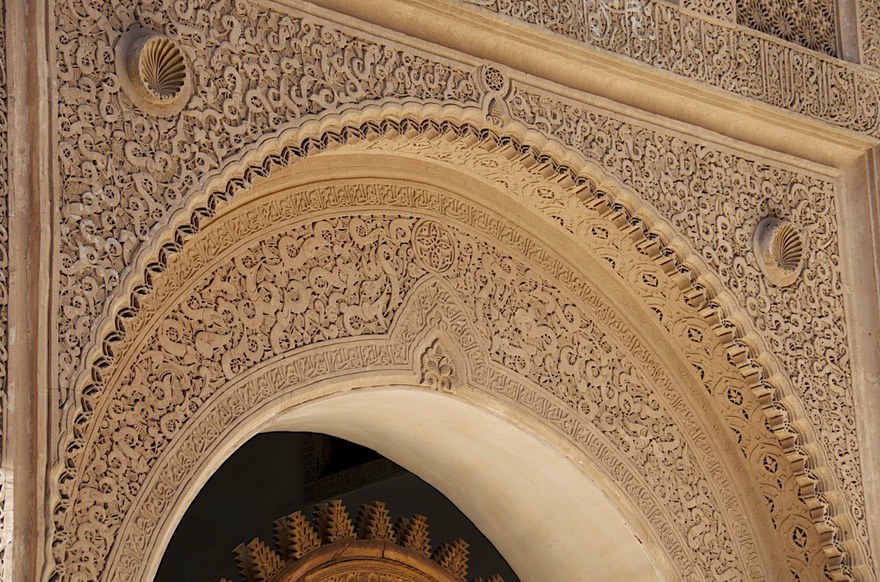
In the medina we were able to make our way to one of the old city’s most astonishing architectural delights, the Ben Youssef Medersa. It was built in the 1330’s and then rebuilt and embellished in the 1560’s. Medersas were schools where students learned the Koran by rote; this one housed 800 individuals in small, monastic cells. It was a fascinating, beautiful place and we were free to wander. We really enjoyed being there, and it gave us a feeling of going back in time to a very simple life.
We spent two nights in Marrakesh. When we first arrived, we headed for a campground north of the city. The big attraction there were the peacocks; they had several, all strutting around and showing off for the ladies; the males were constantly proving who was boss; it was quite a sight and kept us entertained for hours.
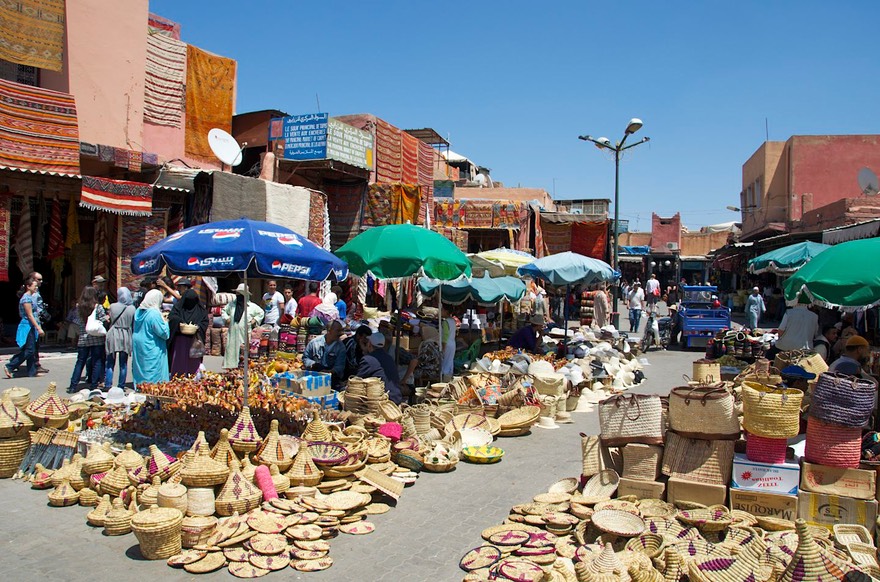
We had been told that if we got up and started early enough the next day, we would be able to find a place for ourselves in a parking lot near the medina and the Djemaa el Fna, the square nearby, scene of all the action both day and night (and where the bomb went off 10 days later). So we managed to do just that; this was a small lot housing an amazing number of vehicles, and they managed to find us a spot. Our first goal was to find the Cyber Park we’d heard about, which was nearby; reportedly we would be able to get good internet access there. Amazingly, this was absolutely true. We had been trying to send out an earlier message to all of you, but had had no success for the last several days. Now – voila! Perfection!
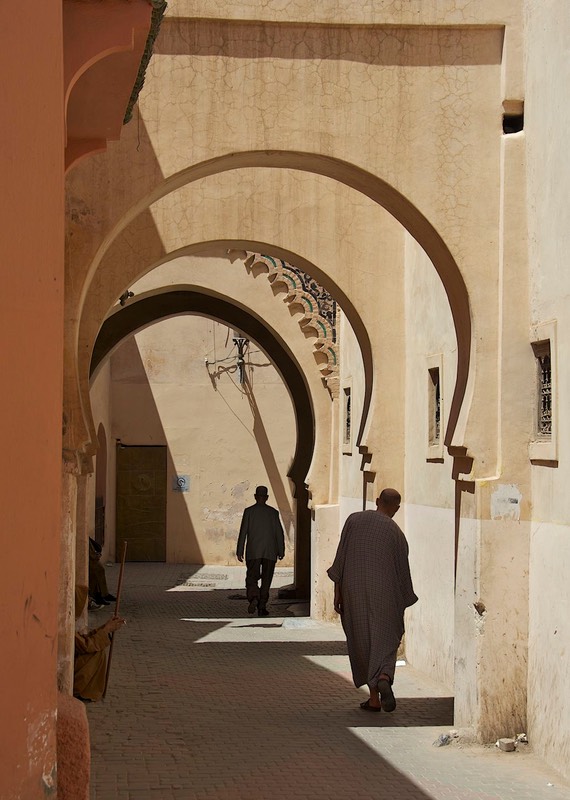
We spent several hours wandering the old city, came back to regroup, and headed back in about dusk. Our walking route took us past the Koutoubia minaret, also a lovely landmark; it was even lovelier at night, with lights all around. It was a warm evening, and people were out in droves; it was a Sunday, which may have contributed to the crowds. As we approached the square, we became part of a huge crowd; it was a real crush. Rick got twitchy, being the responsible member of the family; I was oblivious, entranced by all the fortune-tellers, the dancers, the acrobats, the music-makers, the performing monkeys, the food sellers, even a guy pulling teeth – I kid you not.
We found a bite to eat, and then I suddenly came across the snake charmer. And got a bit frightened. He was so pushy, insisting that he just had to wrap the snake around my neck, and then draping it over my head, and making Rick take my picture, and then having me take a picture of him with the snake wrapped around him. It was quite uncomfortable, and he wanted a lot of money, which we talked down to just a little bit of money because we hadn’t asked for any of his attentions. And then we got the hell out of there, having proven to ourselves once again chaçon à son gout, to each his own.
We spent the night in that parking lot, feeling a little like we’d escaped. The next morning we took some time to walk over to the Ensemble Artisenal; reportedly this had women’s cooperative crafts for sale, with little haggling. Well, terribly disappointing; maybe this was true in times gone by, but these days junky stuff that’s overpriced and being sold by snooty menfolk. So much for that! I only add this because we really would like to be able to support local artisans; but not here, not this way.
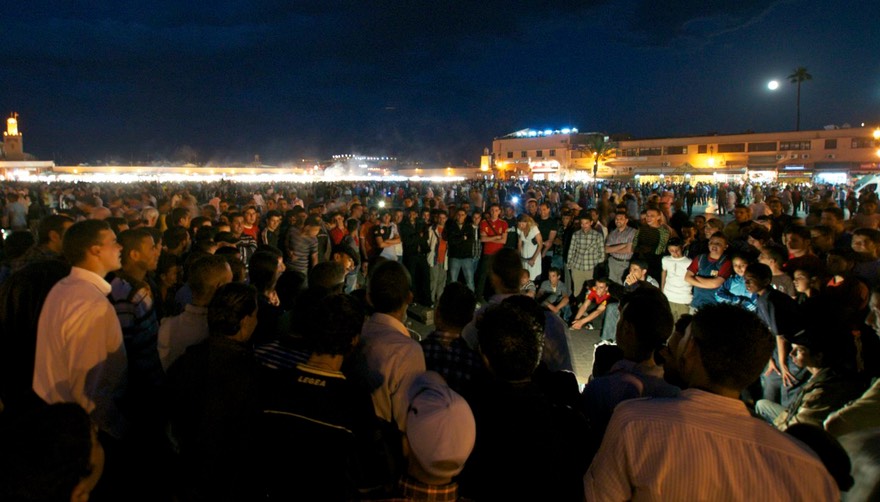
So we beat feet out of Marrakesh. Folks love it here; everyone must have their own experiences. If we had to choose between Fez and Marrakesh, we’d recommend Fez. And get a guide for your first day in the medina. But, for a really wonderful medina experience we’d go back to Chefchouen in a heartbeat, in preference to either of the biggies.
We headed south out of the city, aiming to climb back into the High Atlas Mountains, go over the Tizi n’Tichka pass, and head for Ouarzazate and the big gorges. Suddenly, the Tiger had a big epizootie. For the last week or so, occasionally a light would come on and Rick would make it go away. But now, as we started up the pass and into remote Berber valleys, they became a regular event. What’s an epizootie? In this case it’s a light coming on, chimes going off, and reduced engine power. Bah, Humbug! So, a moment of decision. If we go on, and something serious happens (like when we lost a whole month in deep remote southern Chile), do we really want to be in deep remote high altitude Morocco? Probably not. So, instead, let’s explore some areas closer to “civilization” while we let things develop.
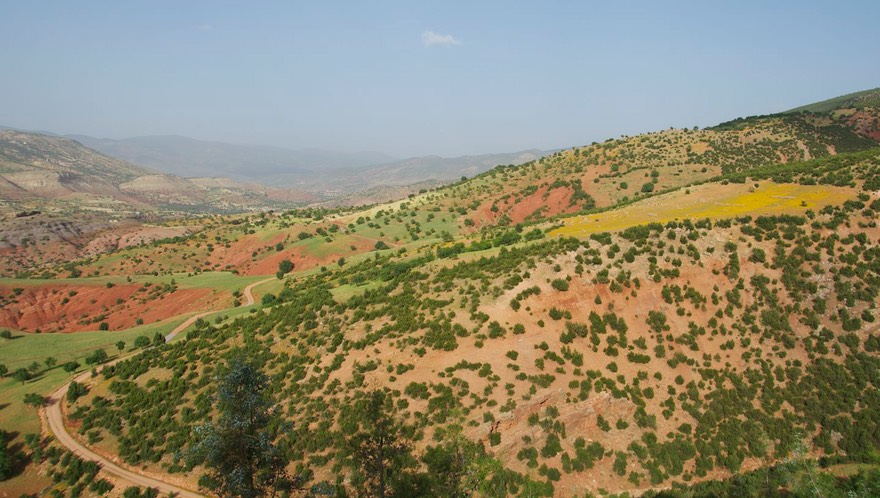
So Rick did something quite brilliant to the engine’s electronics, we turned around, and we headed for some destinations closer in to the city while we waited to see if it would fix the problem (which it did – Marvelous-Man strikes again!).
The Falls near Ouzoud were on our list, and we headed there, ending up at a great campground called Camping Zebra, a small and charming spot owned by a Dutch couple. It had great views over the nearby valley, which is one of the prettiest spots we’ve found in Morocco; this is the area around Azilal. Some of the other campers were returning north from adventures in West Africa; it was fun talking to them. We ended up staying 3 days, and then took off -- totally forgetting to visit the waterfalls; can you believe that! (The truck behaved beautifully on the trip to Ouzoud, and has continued to perform properly ever since. Three cheers for M-M!)
With a rejuvenated Tiger, we headed south again, back into the High Atlas. We enjoyed lush interior valleys, wandering various recommended roads into remote areas seldom visited without a 4-wheel drive. It was terrific. Probably the single loveliest valley was the Aït Boulli, with fruit trees and lush fields full of green wheat.
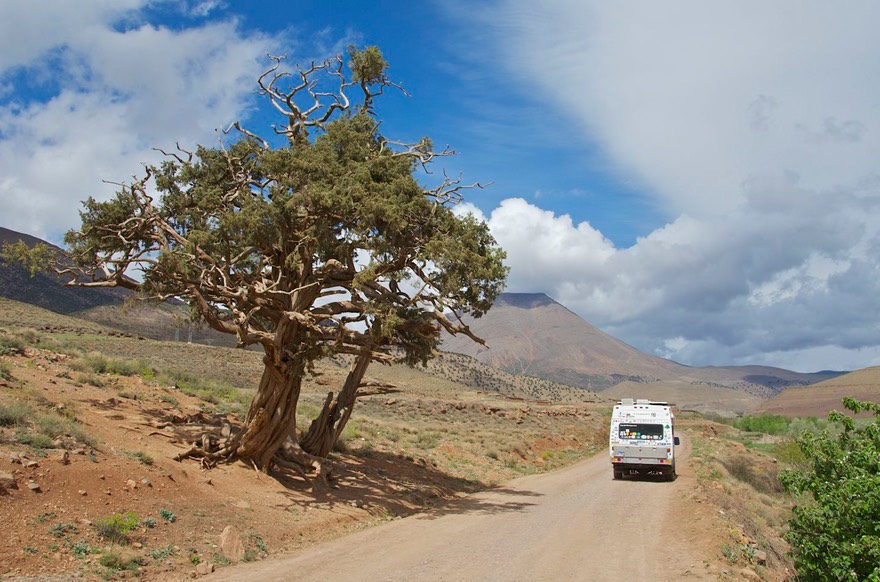
We stopped one night just below a pass; we were at 8500 feet, north of Tabant. The next morning we woke up to fresh snow falling from low hanging clouds. The road ahead was marked good, so we proceeded slowly; we passed a couple of men waiting for the bus; it was 36 degrees and they had built a fire to keep themselves warm. We saw an overturned vehicle down the steep slope right out Rick’s window. No one was around, so we knew it wasn’t a recent event. Hmm. We knew more weather was coming in and we would be staying at high altitude for an extensive distance, so we decided to take a cutoff to a lower elevation. In an hour or so we’d dropped to a more reasonable altitude, and entered the town of Azilal,
Now Azilal was having souk (market day) and they have a very lively animal market. There were critters everywhere, coming and going and being carried hither and yon. To say nothing of all the folks there to enjoy all the doings. It took us quite awhile to gently maneuver amongst the people, who had far more important things on their minds than to jump out of our way. It was a hoot, and so reminiscent of small market towns in South America..
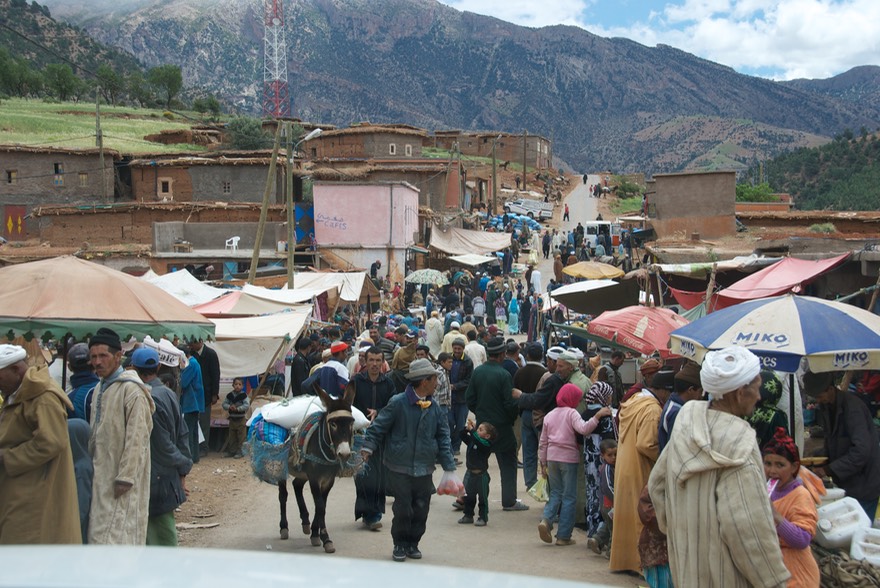
Having survived several days with no problems we decided to go back and tackle the Tizi n’Tichka pass and head once again for Ouarzazate. We ran into a lot of snow at the top and it was 39 degrees; otherwise business as usual. Heading down the other side we detoured to Telouet, with a somewhat-interesting Kasbah and a parking lot for the night. The countryside was very dry, the hillsides were cultivated to high altitude, and suddenly we were reminded of Ecuador.
Heading down into a valley the next day, we went through areas with tremendous geologic histories: the Atlas is quite high, with dramatic folds and outcroppings. A “horizontal” village would have mud houses in several different colors, reflecting the folds of different layers of sediment laid down over the millennia and then bent and twisted by later events. Throughout the mountains, for the most part the houses are built of local mud and straw, so the houses match the mud, and houses on a different level or on the other side of town are a different color. (By the way, the sheep match the local mud as well.) Only in the cities or the more upscale towns would any buildings be painted. The one “decoration” we saw everywhere were brightly painted metal doors.
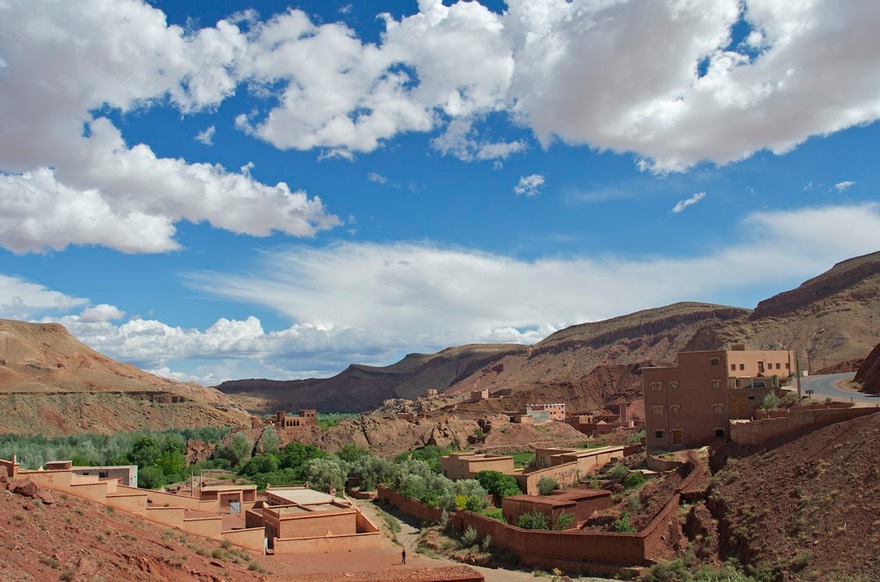
Dropping out of the High Atlas Mountains, we were far enough south to almost be at the start of the desert routes. Ouarzazate is a jumping off place into the desert for many folks, and the town is geared up for tourists. We were a bit startled, having spent so much time in quiet, very isolated mountain communities. This town and area have been the site of many film shootings, and so there is a lot of money around. We knew there was supposed to be decent shopping here, so we wandered a bit. We were disappointed to find it was mostly snack food – and wine. But that was cool; on we went. We were headed for “the gorges.”
There are two very famous gorges in this area, each one cut by enormous rivers. They both run north-south, and are generally approached from the south, both off the same road that runs between Ouarzazate and Tinerhir. The Gorges du Dadès is the first you reach, traveling east from Ouarzazate. It’s really cool and we liked it a lot. We traveled up through this tight series of switchbacks, through marvelous rock formations, then leveled out a bit, then entered the gorge. It was late in the day, the light was good, there was no one there; we enjoyed the serenity and quiet. A few yards beyond the tightest part of the gorge was a lovely hotel with a camping area. We stayed the night and had the place to ourselves. There were locals practicing with their drums for a bit, then total silence except for the stream right along the campsite; this stream is the rushing torrent that carved the gorge.
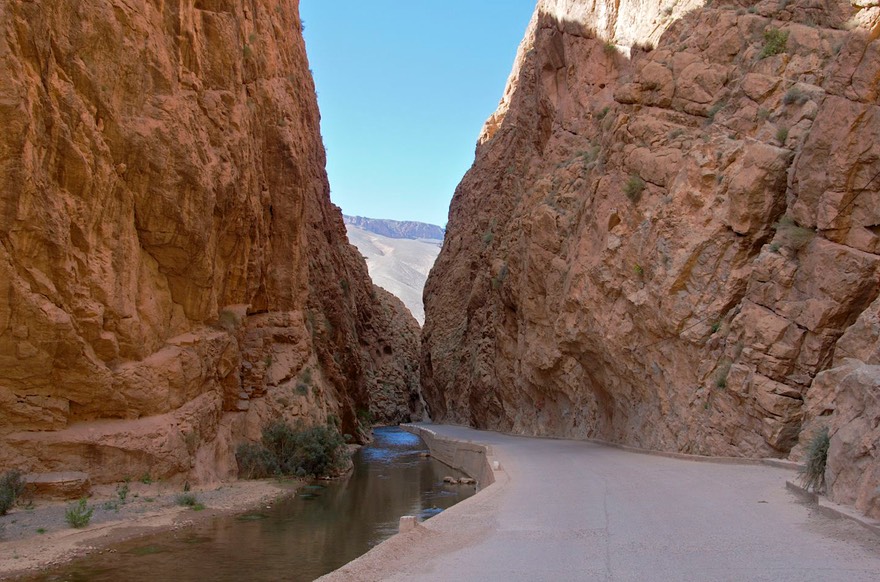
The next morning we walked back to the gorge and enjoyed it some more. Then we drove back to the highway and trucked on over to the beginning of the Todra Gorge. Along the way we watched a passing car rally, made up mostly of Alfa Romeos, which Rick particularly enjoyed; we were both reminded of a similar experience in northwestern Scotland last fall.
Now the Todra Gorge was an entirely different story. And disappointing. It was very touristy, with vendors and touts and tour buses everywhere in the narrow area. It was crowded with folks and cars and you name it. We shrugged and moved on. In actuality, the gorge itself was only our starting point on this road.
A little backtracking: the two gorges run parallel for awhile, then the roads that run through them converge; also, there is a (very bad) piste that connects them part way up. We didn’t want to try the piste; we’d been warned off it by those who know. But…we asked and were told that the road through and above the Todra Gorge was good and would continue north all the way to Imilchil, and beyond there to the lovely Plateau des Lacs and beyond, eventually connecting to major roads after cutting through some very pretty country. We wanted to take this road.
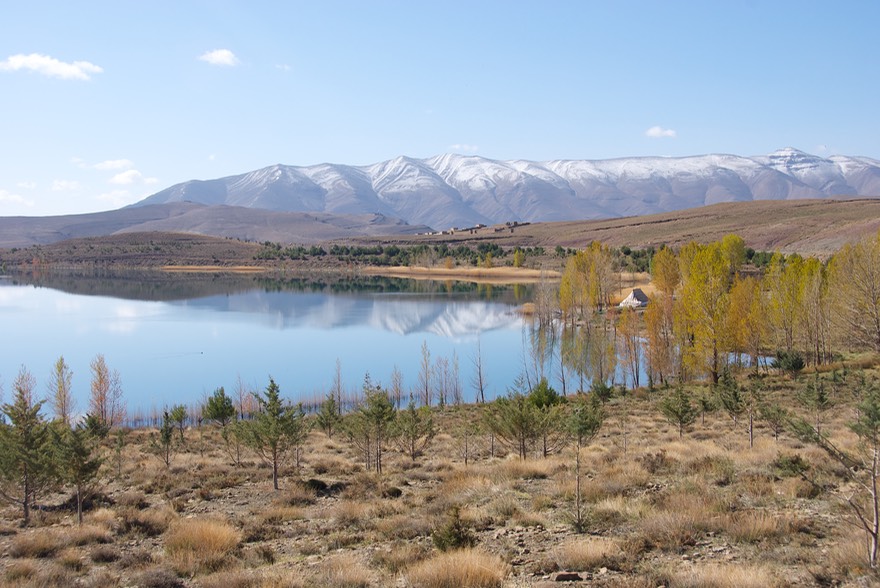
The hotel manager at the Dadès Gorge had asked us where we were going the next day. When I described this route to Imilchil, he rolled his eyes and said “inshallah.” Well, terrific! But we had a lovely time of it and the road was fine and we were absolutely delighted with our choice! We did run into a lot of washouts, but poof, no problema para La Tortuga la Magnifica!
We spent the night on a bluff overlooking Lake Tislit, just north of Imilchil; it was stunning, with snow on the peaks, the water like glass, the poplars in full leaf; it was chilly but just great, at about 7500 feet. We feel this is an all-time great road, with extremely varied country, beautiful views, small Berber villages to see and the local farming being done by hand or mule-drawn plow.
We dropped down into valleys and back up over passes, ending up with the Tizi n’Ifar near El Ksiba; ultimately we were below Azrou, in the “valley” between the Middle and High Atlas, and had rejoined civilization.
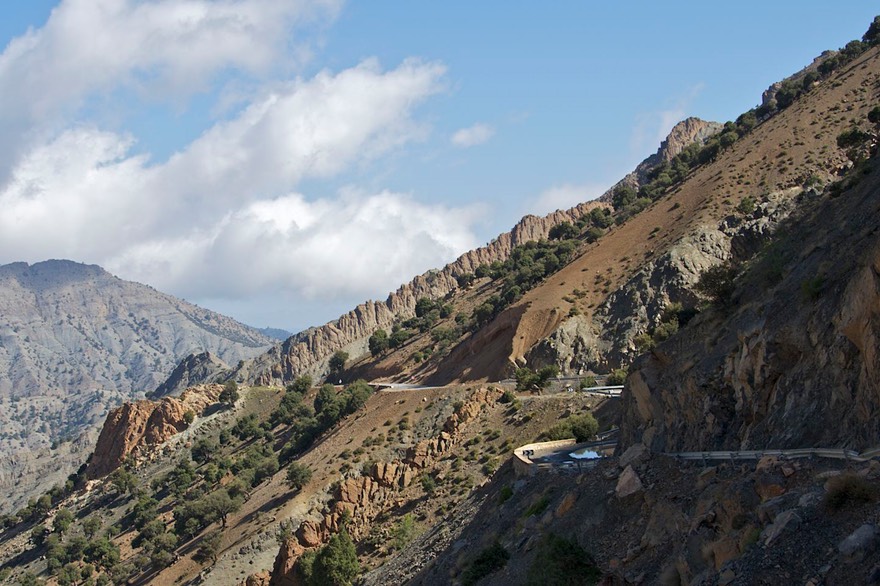
Azrou has a pretty little campground in the middle of a cherry orchard, where we spent a nice night. A group of bikers were camped next to us, and now we have a whole host of new friends in France! The campground has a resident donkey, so we were kept entertained by his “remarks” on the state of his life. The cherries wouldn’t be ripe for another month or so, we figured. We drifted back up to Fez, and our old campground, where we stayed for a couple of days. Laundry, bad weather, and internet access kept us there. Also, we were parked next to an interesting Dutch couple, Har and Gerda, with whom we were enjoying spending time between raindrops.
But now we were ready to leave Morocco and head for new adventures. We could just head due north and the ferry, what do you think? Naah, I want to see some of the Mediterranean coast, she says. So, well, there’s the Rif Mountains and all that hash between us and the coast, he says. We ended up with a plan: we found a road through the Rif that all entities said was safe; we would go to Al Hoceima, about 160 miles east of Tetouan (also on the coast, and where you turn north to the ferry), and then work our way along the coast to Tetouan. This was reportedly a lovely ride, with beautiful views along the rugged coastline. A fitting end to our time in Morocco.
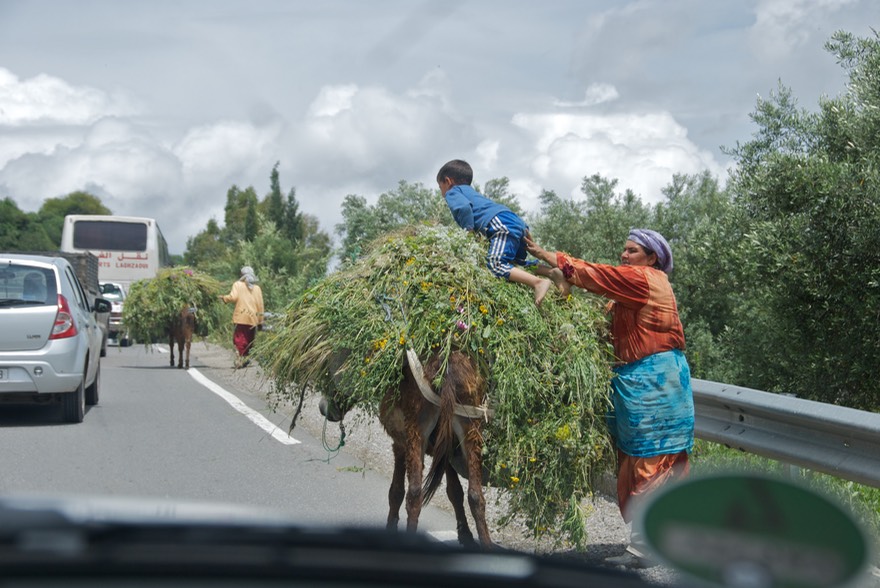
So did it turn out that way? Of course not. The ride through the Rif was, indeed, quite safe, although we did get a lot of strange looks as we went through the rough looking villages. We started out with fields of grain and olives, then higher in the mountains there were small plots of green wheat. It was pretty, and we enjoyed it. The area was wet, and there was a lot of road work that needed to be done on what was by a large margin the roughest paved, numbered highway we’d seen in Morocco; we suspected the area doesn’t get much attention due to its political situation. Eventually we reached the coast and Al Hocema, a major resort. The architecture suddenly became Mediterranean and quite upscale. We found a spot for the night in an undeveloped area down by one of the beaches. It was a lot like a mangrove forest.
In the morning we started west along the coast. For awhile, all went well. We went through tiny villages with all the usual activities. At one point I’ll swear I saw a couple of sheep being loaded into the trunk of a taxi; could it have been true? We even dropped off the main highway for a bit and came to a lovely overlook for a sunny photo of the Mediterranean coast. But, it was getting cloudy, and we knew weather was coming in late in the day, but we hoped we would stay dry and could enjoy the views. Hah! Of course not. But that was later.
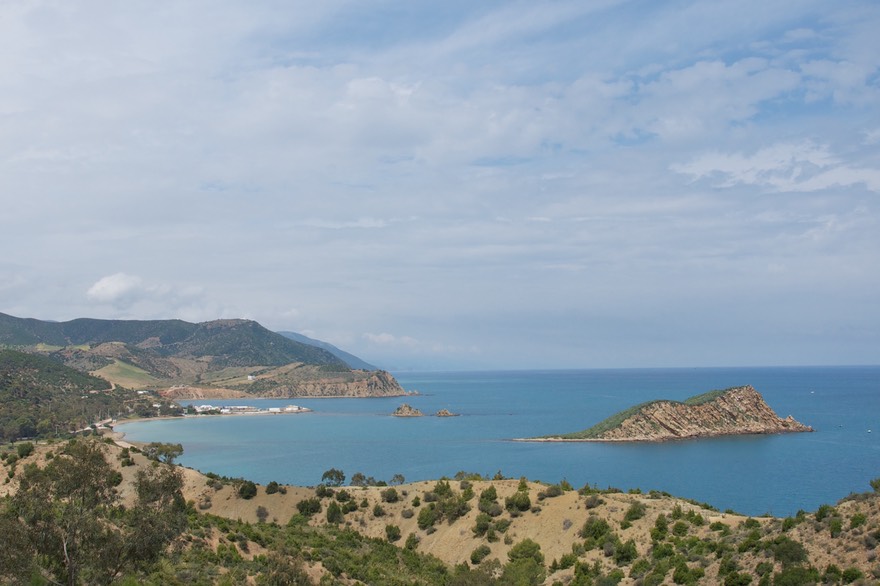
The road was good for about 60 miles. Then we came around a corner and saw that it was all torn up. This “torn up” continued all the way to the outskirts of Tetouan, about 100 miles and 6 hours later. And about an hour along, it began to rain. And didn’t stop. It was absolutely awful. The worst kind of driving. Fortunately, the traffic was light. We went through tiny villages with their (only) street torn up and awash. We passed drenched and sodden folks trudging along, pushing sheep or leading donkeys or just hauling fodder. For them it was just business as usual. This coastal area is, no surprise, wet a lot of the time. Life on the edge! In some indeterminate future, this may become a lovely coastal route, or not. Fellow travelers are strongly advised to check the condition of this route before taking it.
We are in the Tetouan area, gathering ourselves for the drive to the border and the ferry to Spain. We have to leave – we’ve run out of tortillas. We expect to be there in a couple of days – inshallah.
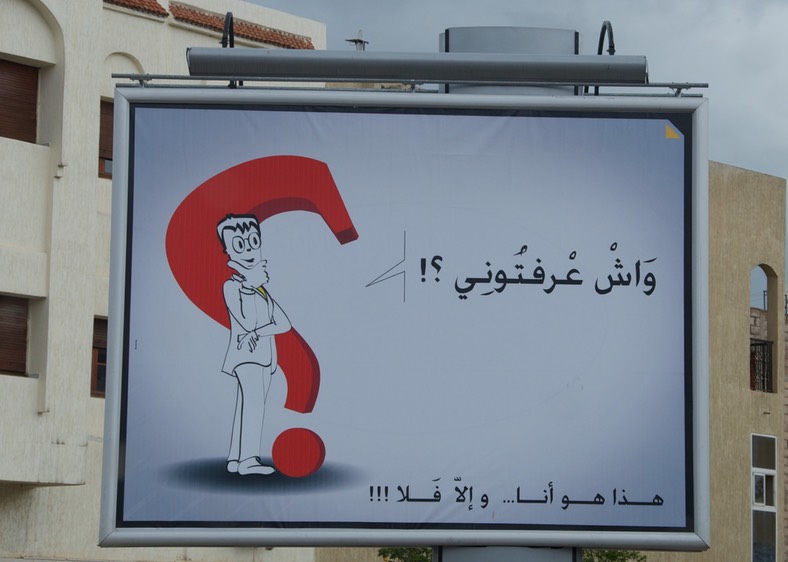
We’ve had a really good time in Morocco, even with the frustrations. The roads are generally very good (and the fuel prices quite low); the scenery has been a knockout and the people quite friendly; we think it’s a great place to spend the winter. Do watch out for the drivers, however: they are all learners, most have cell phones glued to their ears, and they don’t understand how to use a roundabout. As Ted Simon says, in his book Dreaming of Jupiter, remember that you are traveling in the Unfinished World, with all of its charms and difficulties.
We must confess in all honesty though, that there were times, in this, our first Arabic country, when we felt exactly like the fellow in this billboard.
Now we’re off back to Spain, then on to France and points further east. Drop us a line now and then to let us know what you’re doing for fun. Ciao!
Click to see more photos from Morocco